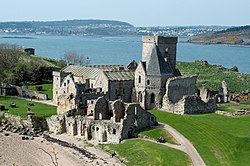Inchcolm Abbey
| Inchcolm Abbey | |
|
Fife | |
|---|---|
 Photograph, 9 April 2011 | |
| Location | |
| Grid reference: | NT18968266 |
| Location: | 56°1’48"N, 3°18’7"W |
| Order: | Augustinian |
| History | |
| Established: | 1147 / 1169 |
| Founder: | King David I and Gregoir, Bishop of Dunkeld |
| Disestablished: | 1609 |
| Information | |
| Owned by: | Historic Scotland |
Inchcolm Abbey is a mediæval abbey whose buildings stand on the island of Inchcolm in the Firth of Forth, within Fife. The Abbey stands at the centre of the island. It was founded in the 12th century during the episcopate of Gregoir, Bishop of Dunkeld. Later tradition placed it even earlier, in the reign of King Alexander I of Scotland (1107–24), who probably had some involvement in the island; he was apparently washed ashore there after a shipwreck in 1123, and took shelter in a hermit's hovel.
The Abbey was first used as a priory by Augustinian canons regular, becoming a full abbey in 1235. The island was attacked by the English from 1296 onwards, and the Abbey was abandoned after the Scottish Reformation in 1560. It has since been used for defensive purposes, as it is situated in a strategically important position in the middle of the Firth of Forth. A mediæval inscription carved above the Abbey's entrance reads "Stet domus haec donec fluctus formica marinos ebibat, et totum testudo perambulet orbem", or, "May this house stand until an ant drains the flowing sea, and a tortoise walks around the whole world".
In July 1581 stones from the abbey were taken to Edinburgh to repair the Tolbooth.[1]
Inchcolm Abbey has the most complete surviving remains of any Scottish monastic house. The cloisters, chapter house, warming house, and refectory are all complete, and most of the remaining claustral buildings survive in a largely complete state. The least well-preserved part of the complex is the monastic church.
The ruins are cared for by Historic Environment Scotland, which also maintains a visitor centre near the landing pier. A ferry runs from South Queensferry in West Lothian.
Inchcolm Antiphoner
The Abbey gives its name to the 14th-century manuscript referred to as the Inchcolm Antiphoner. It contains one of the few remaining examples of Celtic Plainchant. Pages of the Antiphoner can be accessed online in facsimile from the University of Edinburgh.[1]
The Antiphoner contains a substantial number of chants dedicated to Saint Columba. While these may derive from a variety of other monastic foundations with Columban associations, such as Oronsay Priory or Iona, Inchcolm is considered the most likely source of the manuscript's compilation, if not composition.
Outside links
| ("Wikimedia Commons" has material about Inchcolm Abbey) |
- Historic Environment Scotland's page on the abbey
- Cyberscotia's page on the island - including maps, drawings, and photographs
References
- ↑ James David Marwick, Extracts from the records of the Burgh of Edinburgh: 1557-1571 (Edinburgh, 1875), pp. 210, 212.